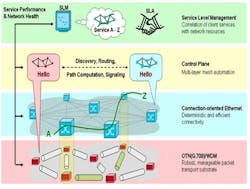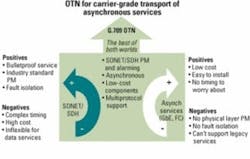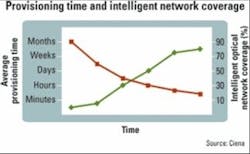Delivering performance-grade Ethernet transport
There are four key features that make Ethernet suitable for WAN deployment in service provider networks: connection-oriented Ethernet transport tunnels; a robust packet transport substrate; mesh-based, multilayer control plane automation; and multilayer service-level management.
By Mitch Auster, Ciena Corp.
According to Infonetics Research, there were 9.2 million IPTV subscribers worldwide in 2006, and that number is expected to reach 65 million by 2010. Led by incumbent carriers' continued deployment of broadband gear, Infonetics forecasts a 63% compound annual growth rate (CAGR) over a five-year period.1
Yankee Group also recently estimated that worldwide Carrier Ethernet E-LAN and E-Line services are expected to grow at a 25% CAGR from 2006, to net more than $23 billion by 2010.
Responding to the increased customer demand for high-bandwidth services, providers have identified Ethernet as a low-cost, simple way to scale bandwidth for the transport of these services—particularly the IP applications that dominate the world of telecommunications—and they are adopting this technology in their networks.
However, traditional Ethernet transport methods do not effectively address the anticipated growth or manageability requirements of these new consumer and business services. Since traditional Ethernet was designed either for best-effort LAN traffic or simple bit transport, Ethernet's shortcomings in the WAN still include difficulty scaling to the volume of service provider customers; lack of end-to-end management architecture; carrier-class reliability and protection schemes; and immature operations, administration, and maintenance (OAM) and quality-of-service (QoS) capabilities.
The ability to manage and scale bandwidth to meet the demands of applications such as triple play requires a new, forward-looking architecture that leverages Carrier Ethernet and transport technologies like Optical Transport Network (OTN) and WDM to make Ethernet performance-grade. Together, these technologies not only scale better than alternatives but offer carrier-class management—a critical element for lowering operational expenses.
While there are a variety of methods to achieve performance-grade Ethernet transport, there are four critical technical areas that make the technology suitable for WAN deployment in service provider networks.
- Connection-oriented Ethernet transport tunnels: Connection-oriented Ethernet transport tunnels allow providers to manage Ethernet as easily as circuits and make the technology more deterministic by disabling the connectionless features that render traditional Ethernet unpredictable.
- Robust packet transport substrate: Connection-oriented Ethernet transport tunnels must be built upon a highly reliable, manageable, and survivable transport substrate. In particular, G.709 OTN brings low-cost, multiprotocol support with SONET/SDH-like performance management and monitoring.
- Mesh-based, multilayer control plane automation: To accommodate expected scaling and increased complexity of service connectivity, control plane automation is necessary to streamline network management processes.
- Multilayer service-level management: Performance-grade Ethernet requires that service providers have the ability to track the individual performance of thousands of Ethernet service connections from end to end across a network and associate those connections with customer service-level agreements (SLAs).
Pseudowires are also a useful component to facilitate a more manageable Ethernet network. Pseudowires complement Ethernet/OTN aggregation networks in the metro to enable Ethernet and other services (e.g., Frame Relay, ATM, and E1/E3) to be carried over IP/MPLS in the core.
These capabilities are illustrated in Fig. 1 and are discussed in more depth below.
Connection-oriented Ethernet transport tunnels
Connection-oriented Ethernet transport tunnels disable unpredictable functions such as media access control (MAC) learning, Spanning Tree Protocol, and "broadcast of unknown" to allow Ethernet to be managed like circuits. This forms the basis for combining the scalability, efficiency, and flexibility advantages of Ethernet with the determinism, reliability, and manageability inherent in SONET/SDH networks, but at a much lower cost.
There are a number of common characteristics of these tunnels that distinguish their performance from traditional, connectionless Ethernet switching, including:
- Connection-oriented: The working (and optional protect) forwarding path is provisioned explicitly via an intelligent control plane or manually through a network management system.
- Bandwidth guarantees: A connection admission control (CAC) function may ensure that traffic parameters of the tunnel can be accommodated by the network end to end.
- QoS: Further, CAC can be used to engineer the traffic entering the tunnels, leveraging both Layer 2 and Layer 3 classification, prioritization, and hierarchical queuing techniques.
- Customer separation: With connection-oriented Ethernet, customer traffic is separated and customer addresses are hidden from the switching domain.
- Assured: The traditional Ethernet functions of MAC learning, flooding, and Spanning Tree are turned off. While these functions make traditional Ethernet plug-and-play, they also make it unpredictable, which is unacceptable for carrier-grade transport.
There are several existing and emerging technologies that can provide the capability for connection-oriented Ethernet transport tunnels. VLAN crossconnect functionality is in fairly widespread use today, but it is expected to give way to Traffic Engineered Provider Backbone Bridging (PBB-TE) in the majority of service provider networks with pockets of T-MPLS expected as well.
G.709 OTN
G.709 OTN or "digital wrapper" brings low-cost, multi-protocol support with SONET/SDH-like performance management and monitoring. It is the ideal standard on which to support not just Ethernet, but many protocols over a converged packet-optical network. OTN specifications provide robust management analogous to SONET/SDH, carry a much larger payload, and guarantee delivery of the underlying payload with its own performance management data intact. For example, OTN can fully encapsulate an OC-192/STM-64 or even a 10.7-Gigabit Ethernet (GbE) LAN PHY frame and guarantee delivery across multiple OTN networks. OTN is not only applicable to SONET/SDH and Ethernet, but also affords the same transparent benefits to asynchronous data services like Fibre Channel, ESCON, and FICON that lack the physical-layer performance monitoring capabilities and fault isolation necessary for high QoS (see Fig. 2).
A recent innovation with OTN is the ability to provide N×155-Mbit/sec channelization of OTU interfaces and links, which provides the most efficient and flexible consumption of metro bandwidth for packet services with right-sized Ethernet transport tunnels multiplexed with other services in the same wavelength. The inherent flexibility of OTN is enabled by extending transparency to the timing plane. This allows the mixing of both synchronous and asynchronous signal types on a common wavelength. Moreover, synchronous services with different clock sources can be transported side-by-side, which is not possible with SONET/SDH.
Pseudowires
Another method for improving the cost structure of Ethernet is to utilize existing carrier infrastructure. Pseudowires enable a service provider to leverage its significant investment in IP/MPLS in the core to handle the growth of Ethernet. Through the use of pseudowires, service providers can efficiently transport Ethernet and other services over MPLS because pseudowires—not unlike OTN—provide transparency of the Layer 1 or Layer 2 services they are emulating over a Layer 2 or Layer 3 packet network.
Pseudowire technology, which the Internet Engineering Task Force (IETF) standardized via the Pseudowire Emulation Edge-to-Edge (PWE3) sub-working group, originated as "draft Martini" and is now defined by RFC 3916 and other ongoing drafts. As the name implies, pseudowires emulate the essential attributes of Layer 1 and Layer 2 services across a converged packet-switched network, most commonly IP/MPLS as shown in Fig. 3. Through the use of pseudowires, Ethernet and other non-IP traffic is sent across an IP/MPLS network while ensuring the service characteristics of that traffic remain intact and uninterrupted.
Pseudowire technology extends the many benefits of performance-grade Ethernet transport networks to the core, including per-service instance OAM, high reliability with strict QoS and network resiliency, scalability, multiservice support with Ethernet interworking, and industry-proven interoperability.
Integrated multilayer management and control planes
Finally, to achieve the highest levels of customer success, deployment, and usability, an effective performance-grade Ethernet transport must provide integrated end-to-end management and control planes. These capabilities ensure that the management of different elements and architectural segments work together in terms of customer provisioning, monitoring, and integration with existing carrier operations support systems (OSSs). Furthermore, integrated control planes enable provisioning tunnels on an end-to-end basis while accounting for the bandwidth and QoS requirements for each individual connection.
Integrated management and control plane is a key enabler to improving reliability and lowering the cost of Ethernet transport. The benefits are easily quantifiable with analyses of capital and operational expenses that reveal significant savings compared with traditional SONET/SDH networks. The dynamic nature of control plane signaling can improve network survivability by implementing a signaling-initiated, mesh-based restoration scheme. In addition to reducing the costs, automation accelerates revenue recognition, provides a competitive differentiator for the service provider, and improves customer satisfaction.
Future evolution of performance-grade Ethernet
The above features combined ensure a high-performance Carrier Ethernet transport that will meet bandwidth and service requirements now and for the foreseeable future. However, with the continued demand for more bandwidth, the next significant step up from 10-Gigabit Ethernet (10GbE) is 100GbE. In fact, a February 2007 Heavy Reading survey of 86 operators reveals that 45% of operators are investigating 100-Gbit/sec technology right now.2
To help drive this progress, the Institute of Electrical and Electronics Engineers' (IEEE) 802.3 Higher Speed Study Group (HSSG) announced earlier this year that it will pursue a standard for 100 Gbits/sec. Developing such a standard is not a short-term effort and will likely take a few years—in addition to the time it takes to develop an underlying technology that will enable 100GbE to operate over existing fiber systems. Although 40-Gbit/sec transport standards are well developed and currently in deployment, the expected lifespan for 40G networks is unclear. However, it is apparent that many of the developments that are making 40G possible, such as new modulation formats and integrated components, can be leveraged to make 100G possible.
For Ethernet transport to thrive in carrier networks, the industry must leverage established optical technologies like OTN that offer scalability, reliability, end-to-end provisioning and service management, and carrier-class network performance management.
Mitch Austeris senior director of service provider solutions marketing at Ciena Corp.
References
- J. Heynen, "IPTV Equipment, Services, Subscribers and Capex 2007," Infonetics, Sept. 13, 2007.
- S. Clavenna, "Long-Haul DWDM: Market & Technology Outlook," Heavy Reading, February 2007.




